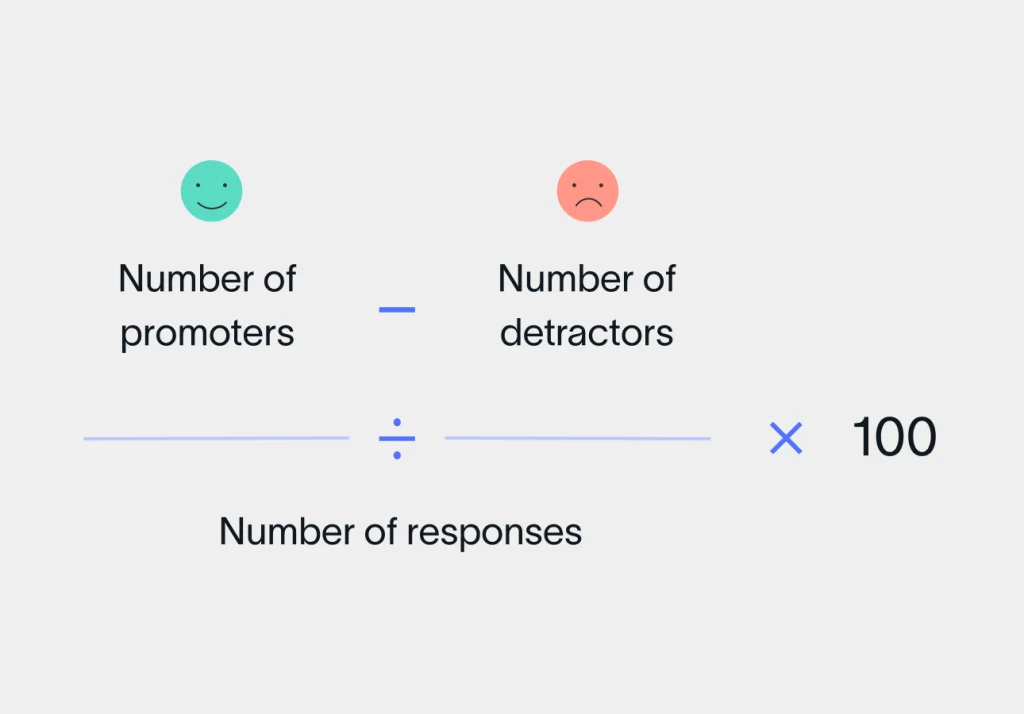Net Promoter Score (NPS)
Introduction to net promoter score (NPS)
Net Promoter Score (NPS) is a widely used metric that measures customer loyalty and their likelihood to recommend a product or service to others. It provides insight into overall customer sentiment and helps businesses identify both their most loyal advocates and potential detractors. By focusing on NPS, companies can better understand their customer base, drive improvements in customer experience, and foster long-term customer relationships.
Table of content
- Introduction to net promoter score (NPS)
- Why NPS matters
- How to measure NPS
- NPS survey question
- Calculating the NPS score
- Best practices for collecting NPS data
- 1. Keep the survey simple
- 2. Timing and frequency
- 3. Segment your audience
- 4. Follow up with customers
- Strategies to improve NPS
- 1. Address detractor feedback
- 2. Enhance the customer experience
- 3. Engage and leverage promoters
- 4. Monitor and act on passive feedback
- Challenges in measuring and improving NPS
- 1. Response bias
- 2. Overemphasis on NPS
- Related topics
Why NPS matters
NPS is crucial for several reasons:
- Customer Loyalty Indicator: NPS directly measures customer loyalty, which is a strong predictor of long-term business success, including repeat purchases and referrals.
- Growth Potential: A high NPS often correlates with strong customer advocacy, leading to organic growth through word-of-mouth and referrals.
- Actionable Insights: By identifying detractors, passives, and promoters, NPS allows businesses to take targeted actions to improve customer satisfaction and reduce churn.
Monitoring and optimizing NPS helps businesses cultivate a loyal customer base that is more likely to stay, spend more, and advocate for the brand.
How to measure NPS
Measuring NPS involves asking customers a simple, focused question about their likelihood to recommend your product or service to others. The responses are then used to calculate the overall NPS score.
NPS survey question
The core NPS survey question is:
“On a scale of 0 to 10, how likely are you to recommend [product/service/company] to a friend or colleague?”
Respondents are classified into three categories based on their ratings:
- Promoters (9-10): Loyal customers who are highly likely to recommend your product or service and contribute positively to your brand’s growth.
- Passives (7-8): Satisfied but unenthusiastic customers who are unlikely to actively promote your brand.
- Detractors (0-6): Unhappy customers who are at risk of churning and may discourage others from using your product or service.
Calculating the NPS score
Subtract the percentage of detractors from the percentage of promoters. (The percentage of passives is not used in the Net Promoter Score formula.) For example, if 20% of the total responses are from detractors, 10% are passives and 70% are promoters, your NPS score would be 70-20 = 50
NPS scores range from -100 to +100. A positive NPS (above 0) indicates that you have more promoters than detractors, while a negative NPS (below 0) suggests that detractors outnumber promoters.

Best practices for collecting NPS data
To ensure that your NPS data is accurate, reliable, and actionable, it’s important to follow best practices in survey design, timing, and analysis.
1. Keep the survey simple
NPS surveys should be straightforward and focused to encourage higher response rates and meaningful feedback.
Best Practices:
- Single Question Focus: Limit the survey to the core NPS question, with an optional follow-up question to gather qualitative feedback.
- Clear Instructions: Ensure that customers understand the rating scale and what each score represents.
2. Timing and frequency
The timing and frequency of NPS surveys can significantly impact the quality of the data collected. Surveys should be sent at key moments in the customer journey.
Best Practices:
- Post-Transaction Surveys: Send NPS surveys after significant interactions, such as a purchase, onboarding, or support resolution, to capture immediate feedback.
- Regular Cadence: Implement a regular cadence for sending NPS surveys, such as quarterly or bi-annually, to track changes in customer sentiment over time.
3. Segment your audience
Segmenting your NPS surveys by customer type, product, or interaction type allows for more granular analysis and targeted improvements.
Best Practices:
- Customer Segmentation: Analyze NPS scores by different customer segments (e.g., new vs. long-term customers) to understand varying levels of satisfaction.
- Product/Service Segmentation: Segment NPS surveys by product or service to identify which areas are driving high or low scores.
4. Follow up with customers
NPS surveys should not be a one-time interaction. Following up with respondents, especially detractors, is crucial for addressing issues and improving the overall customer experience.
Best Practices:
- Thank You Notes: Send a thank-you message to all respondents, acknowledging their feedback and expressing appreciation for their time.
- Detractor Outreach: Reach out to detractors to understand their concerns in more detail and take corrective action where possible.
- Promoter Engagement: Engage with promoters by offering them incentives to refer others, participate in case studies, or provide testimonials.
Measured right, read how the NPS leads to more upselling potential →
Strategies to improve NPS
Improving NPS involves both addressing the concerns of detractors and enhancing the experiences of passives and promoters. Here are key strategies:
1. Address detractor feedback
Detractors are a significant focus area for improving NPS. Understanding and addressing their concerns can help convert them into passives or promoters.
Best Practices:
- Root Cause Analysis: Conduct a detailed analysis of detractor feedback to identify common issues and pain points.
- Action Plans: Develop and implement action plans to address these issues, such as improving product features, enhancing customer support, or refining onboarding processes.
- Personalized Outreach: Reach out to detractors individually to discuss their concerns and provide solutions, demonstrating that you value their feedback.
2. Enhance the customer experience
Improving the overall customer experience across all touchpoints can lead to higher NPS scores, as customers feel more valued and satisfied.
Best Practices:
- Journey Mapping: Use customer journey mapping to identify and optimize key interactions that impact satisfaction and loyalty.
- Personalization: Tailor customer interactions and communications to individual preferences and needs, making customers feel more valued.
- Proactive Support: Offer proactive support and resources to help customers get the most out of your product or service, reducing the likelihood of dissatisfaction.
3. Engage and leverage promoters
Promoters are your brand advocates. Engaging them effectively can amplify their positive impact and drive organic growth.
Best Practices:
- Referral Programs: Create referral programs that incentivize promoters to recommend your product or service to others.
- Exclusive Offers: Offer promoters exclusive deals, early access to new features, or participation in beta programs as a reward for their loyalty.
- Testimonial Collection: Encourage promoters to share their positive experiences through testimonials, case studies, or online reviews.
4. Monitor and act on passive feedback
Passives are satisfied but unenthusiastic customers. Understanding their needs and concerns can help you convert them into promoters.
Best Practices:
- Engagement Strategies: Develop engagement strategies to deepen relationships with passives, such as personalized follow-ups or targeted marketing campaigns.
- Feedback Analysis: Analyze feedback from passives to identify opportunities for enhancing their experience and moving them up the loyalty ladder.
Challenges in measuring and improving NPS
While NPS is a powerful metric, it comes with challenges that need to be managed effectively.
1. Response bias
NPS surveys can be subject to response bias, where only the most extreme responses (very satisfied or very dissatisfied) are captured, potentially skewing the results.
Strategies to Overcome:
- Broad Sampling: Ensure that your NPS surveys reach a wide and representative sample of your customer base to reduce bias.
- Incentivize Responses: Offer incentives to encourage more customers to participate in the survey, increasing the likelihood of a balanced response set.
2. Overemphasis on NPS
Relying solely on NPS can lead to a narrow focus that overlooks other important aspects of customer success, such as Customer Satisfaction (CSAT) or Customer Lifetime Value (CLTV).
Strategies to Overcome:
- Balanced Scorecard: Use NPS alongside other key metrics like CSAT, CLTV, and churn rate to gain a comprehensive view of customer health and success.
- Qualitative Insights: Combine NPS data with qualitative feedback to understand the reasons behind the scores and take more targeted actions.
Related topics
Want to get in touch? Leave us a message.
If you want to learn more about VENMATE and customer success management, feel free to get in touch and request a demo.


